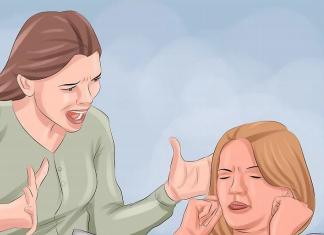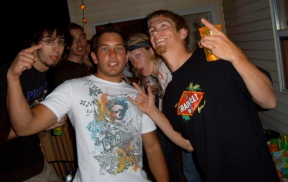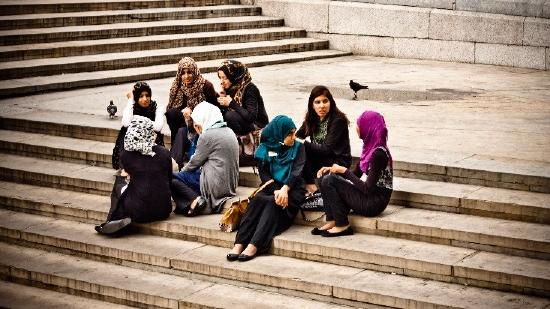15.5: Socialization Agents During Adolescence
- Last updated
- Save as PDF
- Page ID
- 105581
Adolescence is a crucial period in social development, research shows there are four main types of relationships that influence an adolescent: parents, peers, community, and society.
Parents and Teens: Autonomy and Attachment
While most adolescents get along with their parents, they do spend less time with them (Smetana, 2011). This decrease in the time spent with families may be a reflection of a teenager’s greater desire for independence or autonomy. It can be difficult for many parents to deal with this desire for autonomy. However, it is normal for teenagers to increasingly distance themselves and establish relationships outside of their families in preparation for adulthood.
Children in middle and late childhood are increasingly given greater freedom regarding basic decision making. This continues in adolescence, as teens demand more and more control over the decisions that affect their daily lives. Teens believe they should manage the areas that parents previously had considerable control over, which can increase tension between parents and their teenagers. Their arguments often center on issues of a power struggle or conflict in areas such as chores, homework, curfew, dating, personal appearance, and the right to privacy.

As teens grow older, more compromise is reached between parents and teenagers (Smetana, 2011). Teens report more conflict with their mothers, as many mothers believe they should still have some control over many of these areas, yet often report their mothers to be more encouraging and supportive (Costigan, Cauce, & Etchison, 2007). Parents are more controlling of daughters, especially early maturing girls, than they are sons (Caspi, Lynam, Moffitt, & Silva, 1993). In addition, culture and ethnicity also play a role in how restrictive parents are with the daily lives of their children (Chen, Vansteenkiste, Beyers, Soensens, & Van Petegem, 2013). 33
Having supportive, less conflict ridden relationships with parents also benefits teenagers. Research on attachment in adolescence finds that teens who are still securely attached to their parents have less emotional problems (Rawatlal, Kliewer & Pillay, 2015), are less likely to engage in drug abuse and other criminal behaviors (Meeus, Branje & Overbeek, 2004), and have more positive peer relationships (Shomaker & Furman, 2009). This means that both parents and teenagers need to strike a balance between autonomy, while still maintaining close and caring familial relationships. 34
The Parent-Child Relationship
The relationship with parents may be a mitigating factor of the negative influence by peers. Communicating family rules and parental style have been inversely associated to substance, alcohol, and tobacco consumption during adolescence. This influence is essential for adolescents’ development up to adulthood. Communication between parents and adolescents emerges as a protective factor for alcohol, tobacco, and substance use (Newman, Harrison & Dashiff, 2008).
Sen (2010) observed that family meals could lead to creating a closer relation between parents and adolescents, by strengthening a positive relationship and avoiding certain risk behaviors, such as substance use amongst girls and alcohol consumption, physical violence, and robberies, amongst boys. These differences between genders may be due to a greater importance that girls attribute to family activities but they do not reveal that boys are indifferent to them, only that the relation between genders may differ. Huebner and Howell (2003) verified that parental monitoring and communication with parents protected adolescents of both genders from being involved in risk behaviors.

Parental monitoring can be defined as parents’ knowledge about their children’s activities, who they hang out with and what they do. It has been associated to protection of various risk behaviors throughout adolescence, such as substance use or sexual behaviors. The greater the parental monitoring, the lower the adolescents’ involvement in risk behavior. It may vary according to age, gender or ethnicity and it generally decreases with age (Westling, Andrews, Hampson & Peterson, 2008). 36
Relationships with Peers and Peer Groups
Peer Relationships
In addition, peers also serve as an important source of social support and companionship during adolescence. As children become adolescents, they usually begin spending more time with their peers and less time with their families, and these peer interactions are increasingly unsupervised by adults. The level of influence that peers can have over an adolescent makes these relationships particularly important in their personal development. Adolescents with positive peer relationships are happier and better adjusted than those who are socially isolated or have conflictual peer relationships.
Adolescents’ notions of friendship increasingly focus on intimate exchanges of thoughts and feelings, which are important to forming friendships; these high quality friendships may enhance a child’s development regardless of the particular characteristics of those friends. In addition, peers also serve as an important source of social support and companionship during adolescence.
The peer group may serve as a model and influence behaviors and attitudes and also provide easy access, encouragement and an appropriate social setting for consumption (Glaser, Shelton & Bree, 2010). Social Learning Theory suggests that it is not necessary for adolescents to observe a given behavior and adopt it; it is sufficient to perceive that the peer group accepts it, in order to be able to opt for similar behaviors (Petraitis, Flay & Miller, 1995). 37
Peers can serve both positive and negative functions during adolescence. Relationships with peers are valuable opportunities for adolescents to practice their social and conflict resolution skills. But negative peer pressure can lead adolescents to make riskier decisions or engage in more problematic behavior than they would alone or in the presence of their family. One of the most widely studied aspects of adolescent peer influence is known as deviant peer contagion (Dishion & Tipsord, 2011), which is the process by which peers reinforce problem behavior by laughing or showing other signs of approval that then increase the likelihood of future problem behavior. 38
Peers may strongly determine preference in the way of dressing, speaking, using illicit substances, sexual behavior, adopting and accepting violence, adopting criminal and anti-social behaviors, and in many other areas of the adolescent’s life (Padilla, Walker & Bean, 2009; Tomé, Matos & Diniz, 2008). An example of this is that the main motives for alcohol consumption given by adolescents are related to social events, which usually take place in the company of friends, namely: drinking makes holidays more fun, it facilitates approaching others, it helps relaxing or facilitates sharing experiences and feelings (Kuntsche, Knibbe, Gmel & Engels, 2005). Also, mimicking risk behaviors may be greater when consumption begins in the context of a social event (Larsen, Engels, Souren, Granic & Overbeek, 2010).

On the other hand, having friends allows to share experiences and feelings and to learn how to solve conflicts. Not having friends, on the other hand, leads to social isolation and limited social contacts, as there are fewer opportunities to develop new relations and social interactional skills.
Friendship is also positively associated to psychological well-being (Ueno, 2004), Stronger friendships may provide adolescents with an appropriate environment to development in a healthy way and to achieve good academic results. Adolescents with reciprocal friendships mention high levels of feelings of belonging in school; at the same time, reciprocity and feelings of belonging have positive effects in academic results (Vaquera & Kao, 2008).
School is a setting where interpersonal relations are promoted, which are important for youngsters’ personal and social development (Ruini et al., 2009); it is responsible for the transmission of behavioral norms and standards and it represents an essential role in the adolescent’s socialization process. The school is able to gather different peer communities and to promote self-esteem and a harmonious development between adolescents, which makes it a privileged space for meetings and interactions (Baptista, Tomé, Matos, Gaspar & Cruz, 2008). Adolescents spend a great part of their time at school, which also makes it a privileged context for involvement in or protection from risk behaviors (Piko & Kovács, 2010). Camacho, Tomé, Matos, Gamito and Diniz (2010) confirmed that adolescents who like school were those that more often were part of a peer group without involvement in risk behaviors; while those that mentioned they did not have any friends reported that they liked school less and those in conflict with their peers had more negative health outcomes.

Despite the positive influence of the peer group during adolescence, the higher the adolescent’s autonomy from the peer group, the higher their resilience against its influence. This resilience seems to increase with age, which may mean that it is associated with youngsters’ maturity; and girls emerge in several studies as more resilient than boys (Sumter, Bokhorst, Steinberg & Westenberg, 2009).
Another factor that may be found in the influence of the peer group is the type of friendship, which adolescents maintain with their peer group: if friends are close they have a greater influence on the other’s behaviors (Glaser, Shelton & Bree, 2010). When the friendship is perceived as reciprocal and of quality, exerts greater influence (Mercken, Snijders, Steglich, Vartiainen & Vries, 2010). Another factor, which has been identified as a possible way of decreasing peer influence, is assertive refusal. Adolescents that are able to maintain an assertive refusal are less susceptible to the group’s influence (Glaser, Shelton & Bree, 2010). These are only some variables identified as possible factors decreasing peer influence. 41
Peers in Groups
During adolescence, it is common to have friends of the opposite sex much more than in childhood, peer groups evolve from primarily single-sex to mixed-sex. Teens within a peer group tend to be similar to one another in behavior and attitudes, which has been explained as a function of homophily, that is, adolescents who are similar to one another choose to spend time together in a “birds of a feather flock together” way. Adolescents who spend time together also shape each other’s behavior.
Crowds are an emerging level of peer relationships in adolescence. In contrast to friendships, which are reciprocal dyadic relationships, and cliques, which refer to groups of individuals who interact frequently, crowds are characterized by shared reputations or images (who people think they are). Crowds refer to different collections of people, like the “theater kids” or the “environmentalists.” In a way, they are kind of like clothing brands that label the people associated with that crowd. 42


Contributors and Attributions
33. Lifespan Development: A Psychological Perspective by Martha Lally and Suzanne Valentine-French is licensed under CC BY-NC-SA 3.0
34. Lifespan Development: A Psychological Perspective by Martha Lally and Suzanne Valentine-French is licensed under CC BY-NC-SA 3.0
36. How Can Peer Group Influence the Behavior of Adolescents: Explanatory Model by Gina Tomé, Margarida Matos, Celeste Simões, José Diniz, and Inês Camacho is licensed under CC BY 4.0
37. How Can Peer Group Influence the Behavior of Adolescents: Explanatory Model by Gina Tomé, Margarida Matos, Celeste Simões, José Diniz, and Inês Camacho is licensed under CC BY 4.0
38. Boundless Psychology - Adolescence references Curation and Revision by Boundless Psychology, which is licensed under CC BY-SA 4.0
41. How Can Peer Group Influence the Behavior of Adolescents: Explanatory Model by Gina Tomé, Margarida Matos, Celeste Simões, José Diniz, and Inês Camacho is licensed under CC BY 4.0
42. Lifespan Development – Module 7: Adolescence by Lumen Learning is licensed under CC BY 4.0


